Cultural Tourism Report: An Analysis of Timisoara, Romania's Culture
VerifiedAdded on 2020/12/26
|12
|3861
|431
Report
AI Summary
This report provides a detailed analysis of cultural tourism in Timisoara, Romania. It begins with an introduction to cultural tourism and its significance, followed by an investigation of the various cultural tourism typologies available in Timisoara, including historical sites, festivals, rural tourism, and religious tourism. The report then applies the McKercher and Du Cros cultural tourism market framework to categorize tourists based on their interests. The second part of the report analyzes the key issues and concepts surrounding the cultural tourism industry, including social, economic, and environmental factors. It further evaluates the Butler Tourism Life Cycle model in the context of Timisoara's destination development. Finally, the report demonstrates an understanding of the future trends and development of the cultural tourism market, concluding with a summary of the findings and a list of references.
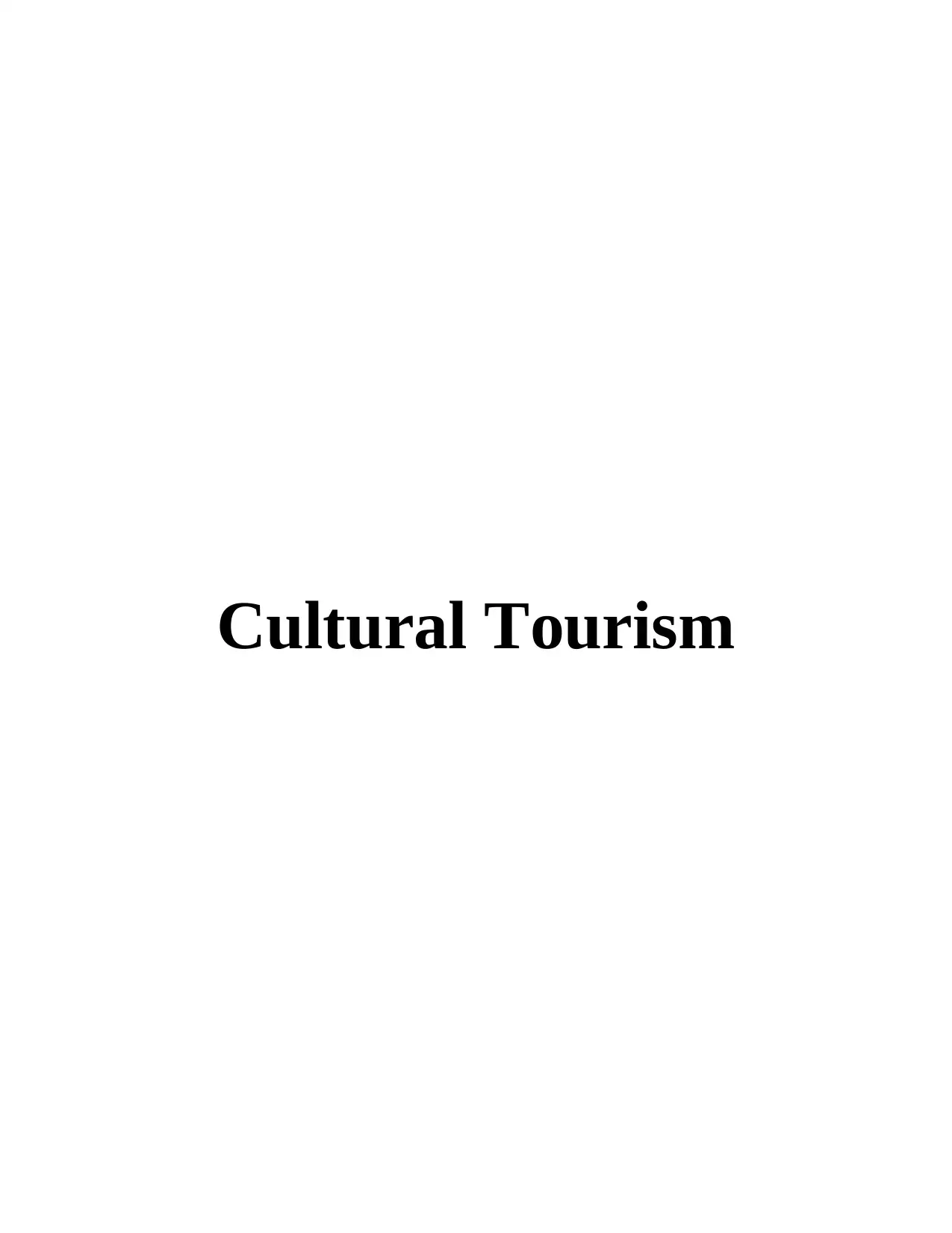
Cultural Tourism
Paraphrase This Document
Need a fresh take? Get an instant paraphrase of this document with our AI Paraphraser
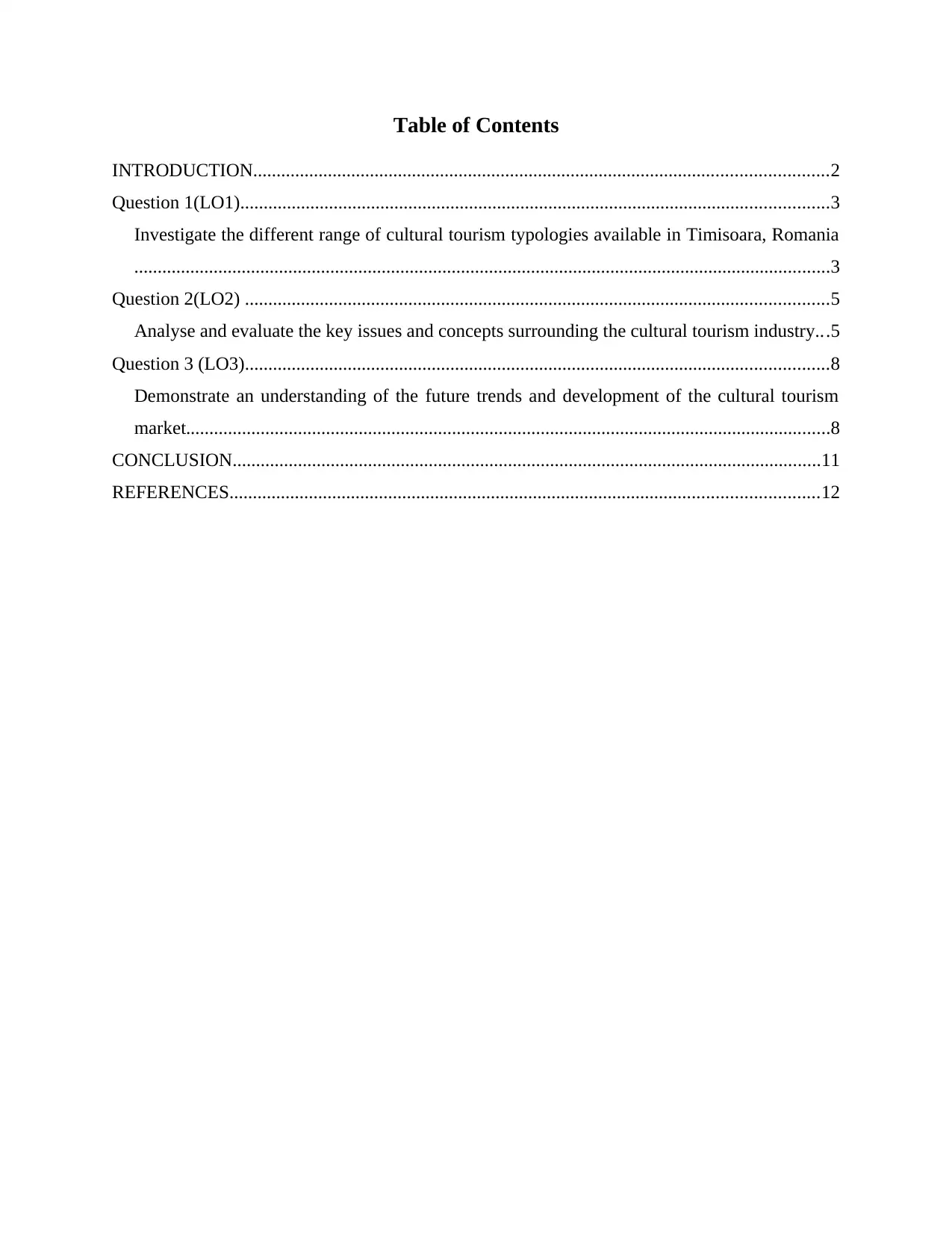
Table of Contents
INTRODUCTION...........................................................................................................................2
Question 1(LO1)..............................................................................................................................3
Investigate the different range of cultural tourism typologies available in Timisoara, Romania
.....................................................................................................................................................3
Question 2(LO2) .............................................................................................................................5
Analyse and evaluate the key issues and concepts surrounding the cultural tourism industry...5
Question 3 (LO3).............................................................................................................................8
Demonstrate an understanding of the future trends and development of the cultural tourism
market..........................................................................................................................................8
CONCLUSION..............................................................................................................................11
REFERENCES..............................................................................................................................12
INTRODUCTION...........................................................................................................................2
Question 1(LO1)..............................................................................................................................3
Investigate the different range of cultural tourism typologies available in Timisoara, Romania
.....................................................................................................................................................3
Question 2(LO2) .............................................................................................................................5
Analyse and evaluate the key issues and concepts surrounding the cultural tourism industry...5
Question 3 (LO3).............................................................................................................................8
Demonstrate an understanding of the future trends and development of the cultural tourism
market..........................................................................................................................................8
CONCLUSION..............................................................................................................................11
REFERENCES..............................................................................................................................12
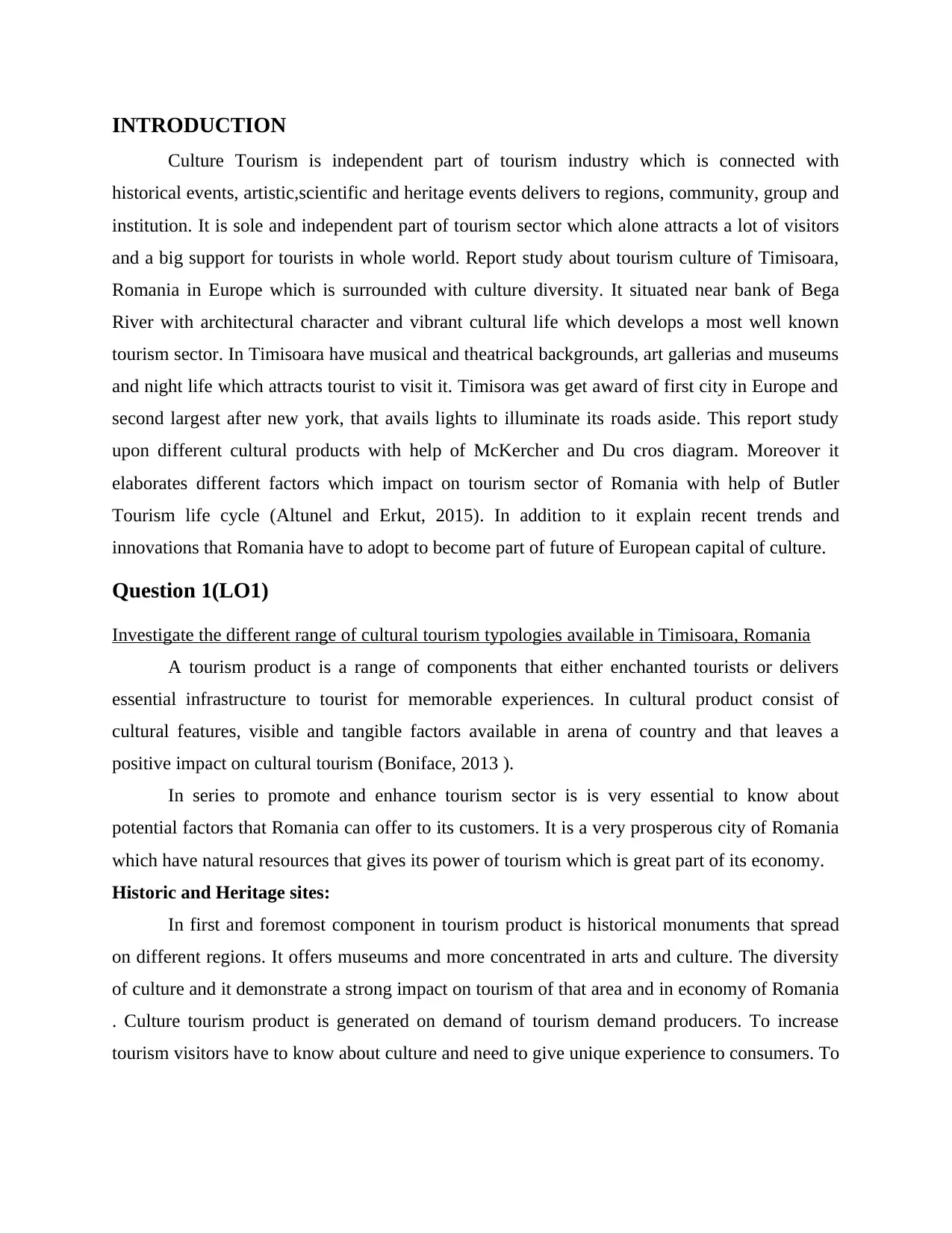
INTRODUCTION
Culture Tourism is independent part of tourism industry which is connected with
historical events, artistic,scientific and heritage events delivers to regions, community, group and
institution. It is sole and independent part of tourism sector which alone attracts a lot of visitors
and a big support for tourists in whole world. Report study about tourism culture of Timisoara,
Romania in Europe which is surrounded with culture diversity. It situated near bank of Bega
River with architectural character and vibrant cultural life which develops a most well known
tourism sector. In Timisoara have musical and theatrical backgrounds, art gallerias and museums
and night life which attracts tourist to visit it. Timisora was get award of first city in Europe and
second largest after new york, that avails lights to illuminate its roads aside. This report study
upon different cultural products with help of McKercher and Du cros diagram. Moreover it
elaborates different factors which impact on tourism sector of Romania with help of Butler
Tourism life cycle (Altunel and Erkut, 2015). In addition to it explain recent trends and
innovations that Romania have to adopt to become part of future of European capital of culture.
Question 1(LO1)
Investigate the different range of cultural tourism typologies available in Timisoara, Romania
A tourism product is a range of components that either enchanted tourists or delivers
essential infrastructure to tourist for memorable experiences. In cultural product consist of
cultural features, visible and tangible factors available in arena of country and that leaves a
positive impact on cultural tourism (Boniface, 2013 ).
In series to promote and enhance tourism sector is is very essential to know about
potential factors that Romania can offer to its customers. It is a very prosperous city of Romania
which have natural resources that gives its power of tourism which is great part of its economy.
Historic and Heritage sites:
In first and foremost component in tourism product is historical monuments that spread
on different regions. It offers museums and more concentrated in arts and culture. The diversity
of culture and it demonstrate a strong impact on tourism of that area and in economy of Romania
. Culture tourism product is generated on demand of tourism demand producers. To increase
tourism visitors have to know about culture and need to give unique experience to consumers. To
Culture Tourism is independent part of tourism industry which is connected with
historical events, artistic,scientific and heritage events delivers to regions, community, group and
institution. It is sole and independent part of tourism sector which alone attracts a lot of visitors
and a big support for tourists in whole world. Report study about tourism culture of Timisoara,
Romania in Europe which is surrounded with culture diversity. It situated near bank of Bega
River with architectural character and vibrant cultural life which develops a most well known
tourism sector. In Timisoara have musical and theatrical backgrounds, art gallerias and museums
and night life which attracts tourist to visit it. Timisora was get award of first city in Europe and
second largest after new york, that avails lights to illuminate its roads aside. This report study
upon different cultural products with help of McKercher and Du cros diagram. Moreover it
elaborates different factors which impact on tourism sector of Romania with help of Butler
Tourism life cycle (Altunel and Erkut, 2015). In addition to it explain recent trends and
innovations that Romania have to adopt to become part of future of European capital of culture.
Question 1(LO1)
Investigate the different range of cultural tourism typologies available in Timisoara, Romania
A tourism product is a range of components that either enchanted tourists or delivers
essential infrastructure to tourist for memorable experiences. In cultural product consist of
cultural features, visible and tangible factors available in arena of country and that leaves a
positive impact on cultural tourism (Boniface, 2013 ).
In series to promote and enhance tourism sector is is very essential to know about
potential factors that Romania can offer to its customers. It is a very prosperous city of Romania
which have natural resources that gives its power of tourism which is great part of its economy.
Historic and Heritage sites:
In first and foremost component in tourism product is historical monuments that spread
on different regions. It offers museums and more concentrated in arts and culture. The diversity
of culture and it demonstrate a strong impact on tourism of that area and in economy of Romania
. Culture tourism product is generated on demand of tourism demand producers. To increase
tourism visitors have to know about culture and need to give unique experience to consumers. To
⊘ This is a preview!⊘
Do you want full access?
Subscribe today to unlock all pages.

Trusted by 1+ million students worldwide
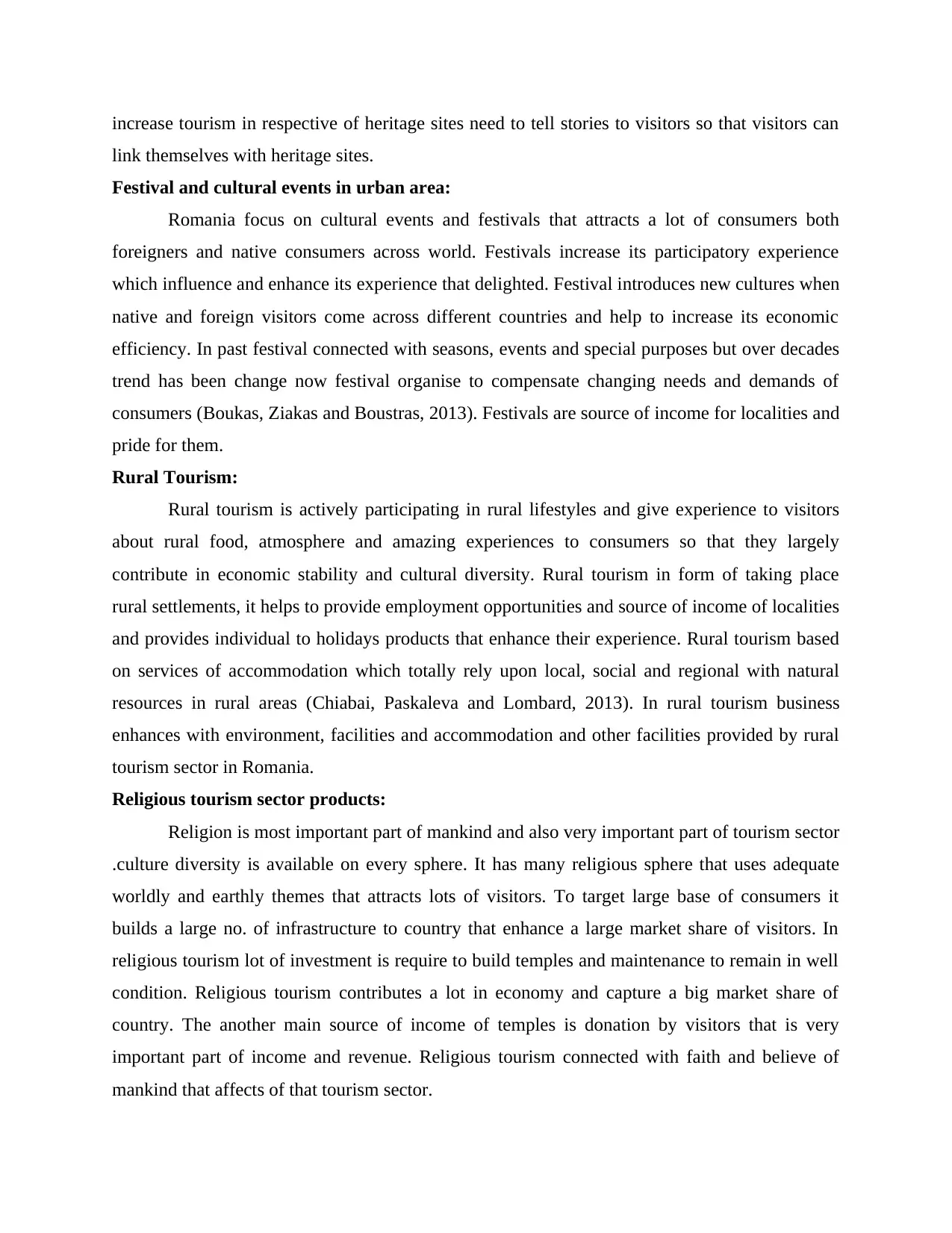
increase tourism in respective of heritage sites need to tell stories to visitors so that visitors can
link themselves with heritage sites.
Festival and cultural events in urban area:
Romania focus on cultural events and festivals that attracts a lot of consumers both
foreigners and native consumers across world. Festivals increase its participatory experience
which influence and enhance its experience that delighted. Festival introduces new cultures when
native and foreign visitors come across different countries and help to increase its economic
efficiency. In past festival connected with seasons, events and special purposes but over decades
trend has been change now festival organise to compensate changing needs and demands of
consumers (Boukas, Ziakas and Boustras, 2013). Festivals are source of income for localities and
pride for them.
Rural Tourism:
Rural tourism is actively participating in rural lifestyles and give experience to visitors
about rural food, atmosphere and amazing experiences to consumers so that they largely
contribute in economic stability and cultural diversity. Rural tourism in form of taking place
rural settlements, it helps to provide employment opportunities and source of income of localities
and provides individual to holidays products that enhance their experience. Rural tourism based
on services of accommodation which totally rely upon local, social and regional with natural
resources in rural areas (Chiabai, Paskaleva and Lombard, 2013). In rural tourism business
enhances with environment, facilities and accommodation and other facilities provided by rural
tourism sector in Romania.
Religious tourism sector products:
Religion is most important part of mankind and also very important part of tourism sector
.culture diversity is available on every sphere. It has many religious sphere that uses adequate
worldly and earthly themes that attracts lots of visitors. To target large base of consumers it
builds a large no. of infrastructure to country that enhance a large market share of visitors. In
religious tourism lot of investment is require to build temples and maintenance to remain in well
condition. Religious tourism contributes a lot in economy and capture a big market share of
country. The another main source of income of temples is donation by visitors that is very
important part of income and revenue. Religious tourism connected with faith and believe of
mankind that affects of that tourism sector.
link themselves with heritage sites.
Festival and cultural events in urban area:
Romania focus on cultural events and festivals that attracts a lot of consumers both
foreigners and native consumers across world. Festivals increase its participatory experience
which influence and enhance its experience that delighted. Festival introduces new cultures when
native and foreign visitors come across different countries and help to increase its economic
efficiency. In past festival connected with seasons, events and special purposes but over decades
trend has been change now festival organise to compensate changing needs and demands of
consumers (Boukas, Ziakas and Boustras, 2013). Festivals are source of income for localities and
pride for them.
Rural Tourism:
Rural tourism is actively participating in rural lifestyles and give experience to visitors
about rural food, atmosphere and amazing experiences to consumers so that they largely
contribute in economic stability and cultural diversity. Rural tourism in form of taking place
rural settlements, it helps to provide employment opportunities and source of income of localities
and provides individual to holidays products that enhance their experience. Rural tourism based
on services of accommodation which totally rely upon local, social and regional with natural
resources in rural areas (Chiabai, Paskaleva and Lombard, 2013). In rural tourism business
enhances with environment, facilities and accommodation and other facilities provided by rural
tourism sector in Romania.
Religious tourism sector products:
Religion is most important part of mankind and also very important part of tourism sector
.culture diversity is available on every sphere. It has many religious sphere that uses adequate
worldly and earthly themes that attracts lots of visitors. To target large base of consumers it
builds a large no. of infrastructure to country that enhance a large market share of visitors. In
religious tourism lot of investment is require to build temples and maintenance to remain in well
condition. Religious tourism contributes a lot in economy and capture a big market share of
country. The another main source of income of temples is donation by visitors that is very
important part of income and revenue. Religious tourism connected with faith and believe of
mankind that affects of that tourism sector.
Paraphrase This Document
Need a fresh take? Get an instant paraphrase of this document with our AI Paraphraser
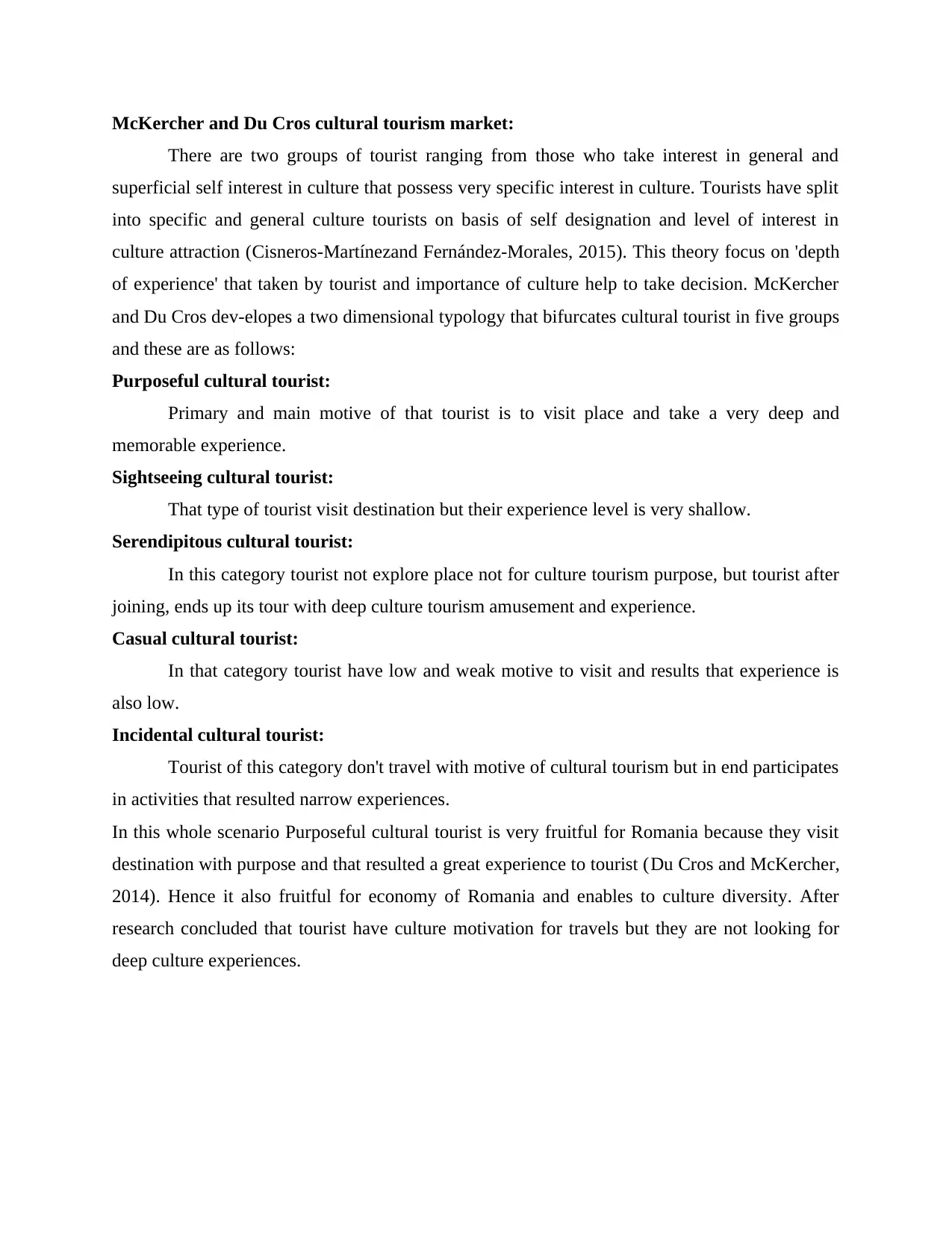
McKercher and Du Cros cultural tourism market:
There are two groups of tourist ranging from those who take interest in general and
superficial self interest in culture that possess very specific interest in culture. Tourists have split
into specific and general culture tourists on basis of self designation and level of interest in
culture attraction (Cisneros-Martínezand Fernández-Morales, 2015). This theory focus on 'depth
of experience' that taken by tourist and importance of culture help to take decision. McKercher
and Du Cros dev-elopes a two dimensional typology that bifurcates cultural tourist in five groups
and these are as follows:
Purposeful cultural tourist:
Primary and main motive of that tourist is to visit place and take a very deep and
memorable experience.
Sightseeing cultural tourist:
That type of tourist visit destination but their experience level is very shallow.
Serendipitous cultural tourist:
In this category tourist not explore place not for culture tourism purpose, but tourist after
joining, ends up its tour with deep culture tourism amusement and experience.
Casual cultural tourist:
In that category tourist have low and weak motive to visit and results that experience is
also low.
Incidental cultural tourist:
Tourist of this category don't travel with motive of cultural tourism but in end participates
in activities that resulted narrow experiences.
In this whole scenario Purposeful cultural tourist is very fruitful for Romania because they visit
destination with purpose and that resulted a great experience to tourist (Du Cros and McKercher,
2014). Hence it also fruitful for economy of Romania and enables to culture diversity. After
research concluded that tourist have culture motivation for travels but they are not looking for
deep culture experiences.
There are two groups of tourist ranging from those who take interest in general and
superficial self interest in culture that possess very specific interest in culture. Tourists have split
into specific and general culture tourists on basis of self designation and level of interest in
culture attraction (Cisneros-Martínezand Fernández-Morales, 2015). This theory focus on 'depth
of experience' that taken by tourist and importance of culture help to take decision. McKercher
and Du Cros dev-elopes a two dimensional typology that bifurcates cultural tourist in five groups
and these are as follows:
Purposeful cultural tourist:
Primary and main motive of that tourist is to visit place and take a very deep and
memorable experience.
Sightseeing cultural tourist:
That type of tourist visit destination but their experience level is very shallow.
Serendipitous cultural tourist:
In this category tourist not explore place not for culture tourism purpose, but tourist after
joining, ends up its tour with deep culture tourism amusement and experience.
Casual cultural tourist:
In that category tourist have low and weak motive to visit and results that experience is
also low.
Incidental cultural tourist:
Tourist of this category don't travel with motive of cultural tourism but in end participates
in activities that resulted narrow experiences.
In this whole scenario Purposeful cultural tourist is very fruitful for Romania because they visit
destination with purpose and that resulted a great experience to tourist (Du Cros and McKercher,
2014). Hence it also fruitful for economy of Romania and enables to culture diversity. After
research concluded that tourist have culture motivation for travels but they are not looking for
deep culture experiences.
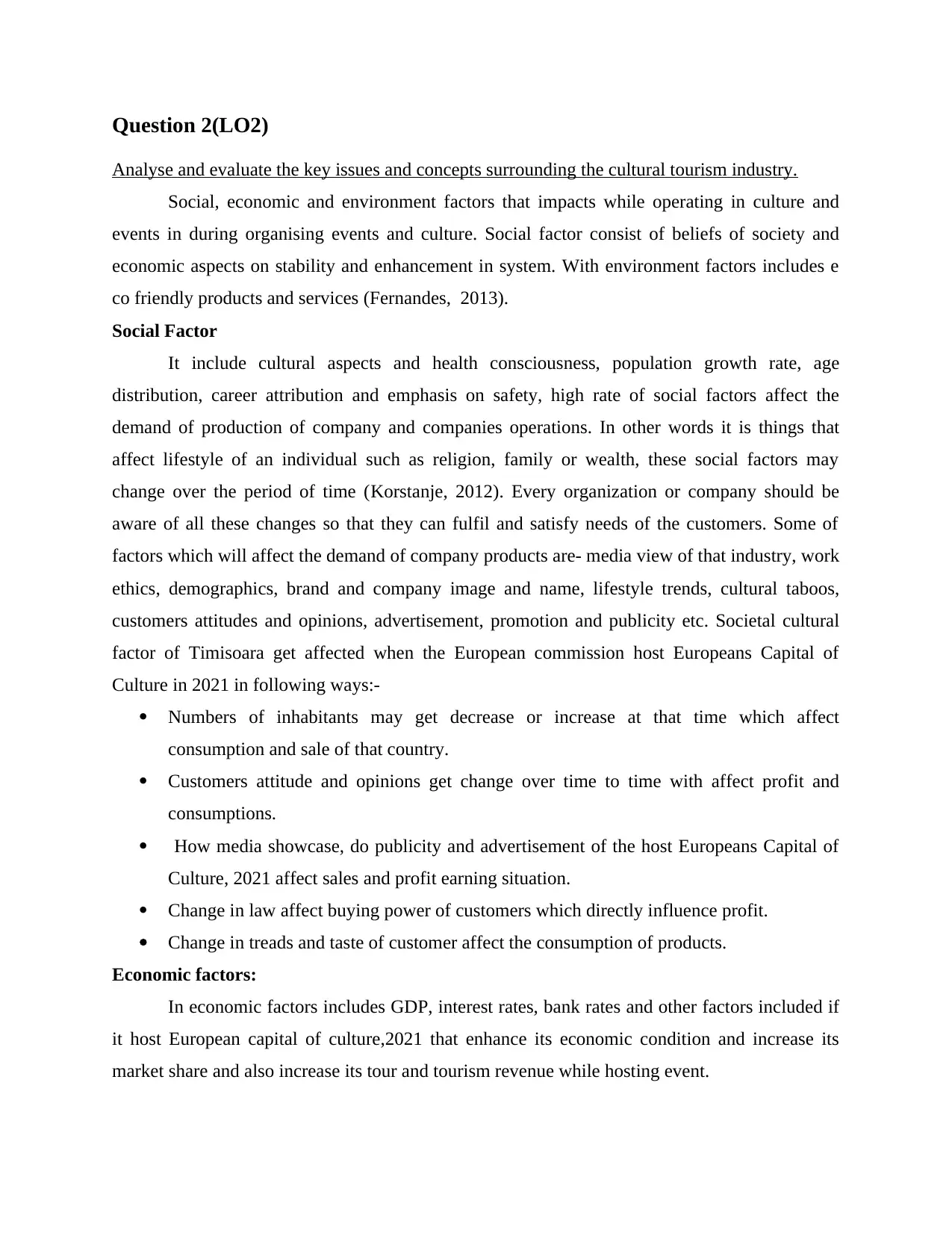
Question 2(LO2)
Analyse and evaluate the key issues and concepts surrounding the cultural tourism industry.
Social, economic and environment factors that impacts while operating in culture and
events in during organising events and culture. Social factor consist of beliefs of society and
economic aspects on stability and enhancement in system. With environment factors includes e
co friendly products and services (Fernandes, 2013).
Social Factor
It include cultural aspects and health consciousness, population growth rate, age
distribution, career attribution and emphasis on safety, high rate of social factors affect the
demand of production of company and companies operations. In other words it is things that
affect lifestyle of an individual such as religion, family or wealth, these social factors may
change over the period of time (Korstanje, 2012). Every organization or company should be
aware of all these changes so that they can fulfil and satisfy needs of the customers. Some of
factors which will affect the demand of company products are- media view of that industry, work
ethics, demographics, brand and company image and name, lifestyle trends, cultural taboos,
customers attitudes and opinions, advertisement, promotion and publicity etc. Societal cultural
factor of Timisoara get affected when the European commission host Europeans Capital of
Culture in 2021 in following ways:-
Numbers of inhabitants may get decrease or increase at that time which affect
consumption and sale of that country.
Customers attitude and opinions get change over time to time with affect profit and
consumptions.
How media showcase, do publicity and advertisement of the host Europeans Capital of
Culture, 2021 affect sales and profit earning situation.
Change in law affect buying power of customers which directly influence profit.
Change in treads and taste of customer affect the consumption of products.
Economic factors:
In economic factors includes GDP, interest rates, bank rates and other factors included if
it host European capital of culture,2021 that enhance its economic condition and increase its
market share and also increase its tour and tourism revenue while hosting event.
Analyse and evaluate the key issues and concepts surrounding the cultural tourism industry.
Social, economic and environment factors that impacts while operating in culture and
events in during organising events and culture. Social factor consist of beliefs of society and
economic aspects on stability and enhancement in system. With environment factors includes e
co friendly products and services (Fernandes, 2013).
Social Factor
It include cultural aspects and health consciousness, population growth rate, age
distribution, career attribution and emphasis on safety, high rate of social factors affect the
demand of production of company and companies operations. In other words it is things that
affect lifestyle of an individual such as religion, family or wealth, these social factors may
change over the period of time (Korstanje, 2012). Every organization or company should be
aware of all these changes so that they can fulfil and satisfy needs of the customers. Some of
factors which will affect the demand of company products are- media view of that industry, work
ethics, demographics, brand and company image and name, lifestyle trends, cultural taboos,
customers attitudes and opinions, advertisement, promotion and publicity etc. Societal cultural
factor of Timisoara get affected when the European commission host Europeans Capital of
Culture in 2021 in following ways:-
Numbers of inhabitants may get decrease or increase at that time which affect
consumption and sale of that country.
Customers attitude and opinions get change over time to time with affect profit and
consumptions.
How media showcase, do publicity and advertisement of the host Europeans Capital of
Culture, 2021 affect sales and profit earning situation.
Change in law affect buying power of customers which directly influence profit.
Change in treads and taste of customer affect the consumption of products.
Economic factors:
In economic factors includes GDP, interest rates, bank rates and other factors included if
it host European capital of culture,2021 that enhance its economic condition and increase its
market share and also increase its tour and tourism revenue while hosting event.
⊘ This is a preview!⊘
Do you want full access?
Subscribe today to unlock all pages.

Trusted by 1+ million students worldwide
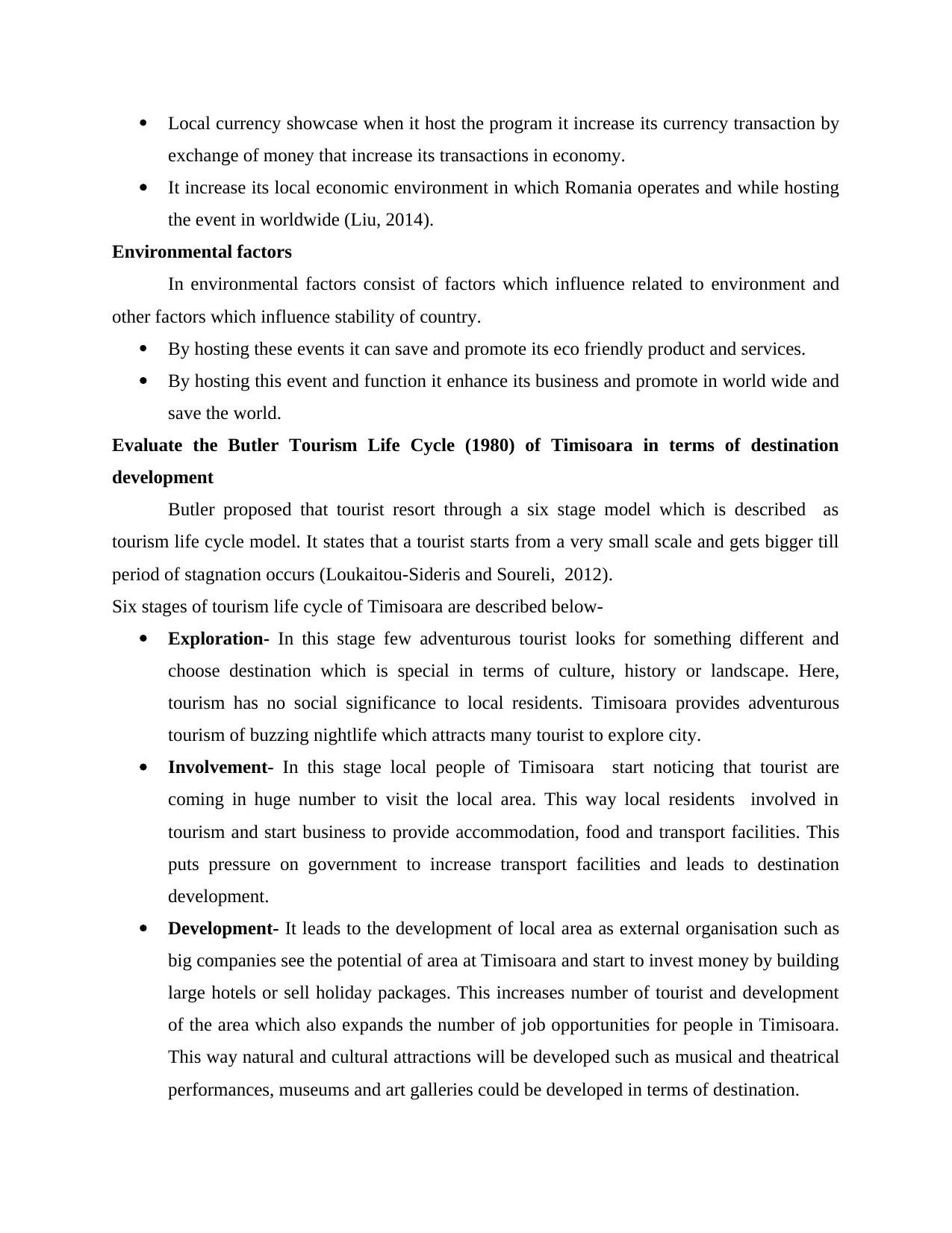
Local currency showcase when it host the program it increase its currency transaction by
exchange of money that increase its transactions in economy.
It increase its local economic environment in which Romania operates and while hosting
the event in worldwide (Liu, 2014).
Environmental factors
In environmental factors consist of factors which influence related to environment and
other factors which influence stability of country.
By hosting these events it can save and promote its eco friendly product and services.
By hosting this event and function it enhance its business and promote in world wide and
save the world.
Evaluate the Butler Tourism Life Cycle (1980) of Timisoara in terms of destination
development
Butler proposed that tourist resort through a six stage model which is described as
tourism life cycle model. It states that a tourist starts from a very small scale and gets bigger till
period of stagnation occurs (Loukaitou-Sideris and Soureli, 2012).
Six stages of tourism life cycle of Timisoara are described below-
Exploration- In this stage few adventurous tourist looks for something different and
choose destination which is special in terms of culture, history or landscape. Here,
tourism has no social significance to local residents. Timisoara provides adventurous
tourism of buzzing nightlife which attracts many tourist to explore city.
Involvement- In this stage local people of Timisoara start noticing that tourist are
coming in huge number to visit the local area. This way local residents involved in
tourism and start business to provide accommodation, food and transport facilities. This
puts pressure on government to increase transport facilities and leads to destination
development.
Development- It leads to the development of local area as external organisation such as
big companies see the potential of area at Timisoara and start to invest money by building
large hotels or sell holiday packages. This increases number of tourist and development
of the area which also expands the number of job opportunities for people in Timisoara.
This way natural and cultural attractions will be developed such as musical and theatrical
performances, museums and art galleries could be developed in terms of destination.
exchange of money that increase its transactions in economy.
It increase its local economic environment in which Romania operates and while hosting
the event in worldwide (Liu, 2014).
Environmental factors
In environmental factors consist of factors which influence related to environment and
other factors which influence stability of country.
By hosting these events it can save and promote its eco friendly product and services.
By hosting this event and function it enhance its business and promote in world wide and
save the world.
Evaluate the Butler Tourism Life Cycle (1980) of Timisoara in terms of destination
development
Butler proposed that tourist resort through a six stage model which is described as
tourism life cycle model. It states that a tourist starts from a very small scale and gets bigger till
period of stagnation occurs (Loukaitou-Sideris and Soureli, 2012).
Six stages of tourism life cycle of Timisoara are described below-
Exploration- In this stage few adventurous tourist looks for something different and
choose destination which is special in terms of culture, history or landscape. Here,
tourism has no social significance to local residents. Timisoara provides adventurous
tourism of buzzing nightlife which attracts many tourist to explore city.
Involvement- In this stage local people of Timisoara start noticing that tourist are
coming in huge number to visit the local area. This way local residents involved in
tourism and start business to provide accommodation, food and transport facilities. This
puts pressure on government to increase transport facilities and leads to destination
development.
Development- It leads to the development of local area as external organisation such as
big companies see the potential of area at Timisoara and start to invest money by building
large hotels or sell holiday packages. This increases number of tourist and development
of the area which also expands the number of job opportunities for people in Timisoara.
This way natural and cultural attractions will be developed such as musical and theatrical
performances, museums and art galleries could be developed in terms of destination.
Paraphrase This Document
Need a fresh take? Get an instant paraphrase of this document with our AI Paraphraser
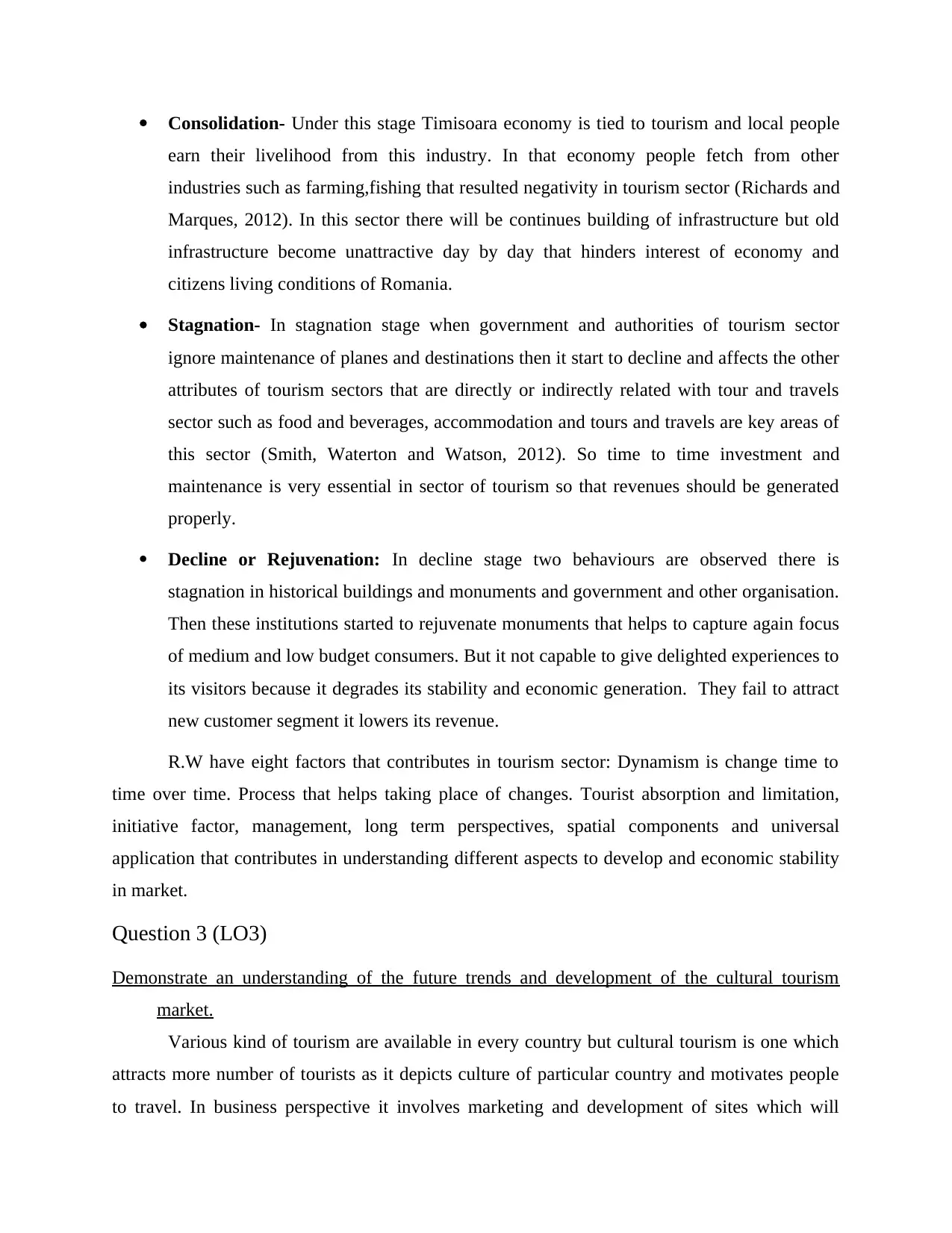
Consolidation- Under this stage Timisoara economy is tied to tourism and local people
earn their livelihood from this industry. In that economy people fetch from other
industries such as farming,fishing that resulted negativity in tourism sector (Richards and
Marques, 2012). In this sector there will be continues building of infrastructure but old
infrastructure become unattractive day by day that hinders interest of economy and
citizens living conditions of Romania.
Stagnation- In stagnation stage when government and authorities of tourism sector
ignore maintenance of planes and destinations then it start to decline and affects the other
attributes of tourism sectors that are directly or indirectly related with tour and travels
sector such as food and beverages, accommodation and tours and travels are key areas of
this sector (Smith, Waterton and Watson, 2012). So time to time investment and
maintenance is very essential in sector of tourism so that revenues should be generated
properly.
Decline or Rejuvenation: In decline stage two behaviours are observed there is
stagnation in historical buildings and monuments and government and other organisation.
Then these institutions started to rejuvenate monuments that helps to capture again focus
of medium and low budget consumers. But it not capable to give delighted experiences to
its visitors because it degrades its stability and economic generation. They fail to attract
new customer segment it lowers its revenue.
R.W have eight factors that contributes in tourism sector: Dynamism is change time to
time over time. Process that helps taking place of changes. Tourist absorption and limitation,
initiative factor, management, long term perspectives, spatial components and universal
application that contributes in understanding different aspects to develop and economic stability
in market.
Question 3 (LO3)
Demonstrate an understanding of the future trends and development of the cultural tourism
market.
Various kind of tourism are available in every country but cultural tourism is one which
attracts more number of tourists as it depicts culture of particular country and motivates people
to travel. In business perspective it involves marketing and development of sites which will
earn their livelihood from this industry. In that economy people fetch from other
industries such as farming,fishing that resulted negativity in tourism sector (Richards and
Marques, 2012). In this sector there will be continues building of infrastructure but old
infrastructure become unattractive day by day that hinders interest of economy and
citizens living conditions of Romania.
Stagnation- In stagnation stage when government and authorities of tourism sector
ignore maintenance of planes and destinations then it start to decline and affects the other
attributes of tourism sectors that are directly or indirectly related with tour and travels
sector such as food and beverages, accommodation and tours and travels are key areas of
this sector (Smith, Waterton and Watson, 2012). So time to time investment and
maintenance is very essential in sector of tourism so that revenues should be generated
properly.
Decline or Rejuvenation: In decline stage two behaviours are observed there is
stagnation in historical buildings and monuments and government and other organisation.
Then these institutions started to rejuvenate monuments that helps to capture again focus
of medium and low budget consumers. But it not capable to give delighted experiences to
its visitors because it degrades its stability and economic generation. They fail to attract
new customer segment it lowers its revenue.
R.W have eight factors that contributes in tourism sector: Dynamism is change time to
time over time. Process that helps taking place of changes. Tourist absorption and limitation,
initiative factor, management, long term perspectives, spatial components and universal
application that contributes in understanding different aspects to develop and economic stability
in market.
Question 3 (LO3)
Demonstrate an understanding of the future trends and development of the cultural tourism
market.
Various kind of tourism are available in every country but cultural tourism is one which
attracts more number of tourists as it depicts culture of particular country and motivates people
to travel. In business perspective it involves marketing and development of sites which will
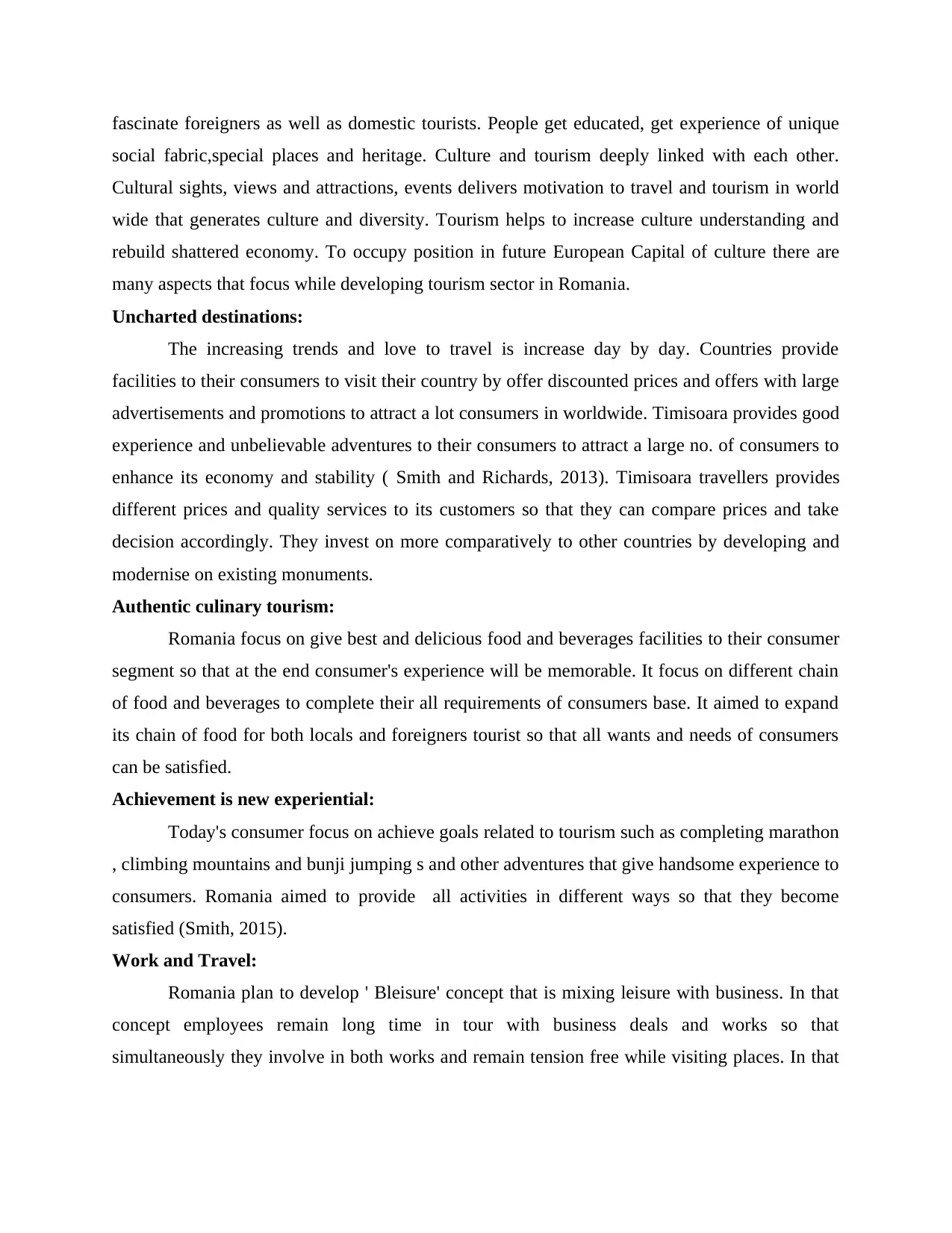
fascinate foreigners as well as domestic tourists. People get educated, get experience of unique
social fabric,special places and heritage. Culture and tourism deeply linked with each other.
Cultural sights, views and attractions, events delivers motivation to travel and tourism in world
wide that generates culture and diversity. Tourism helps to increase culture understanding and
rebuild shattered economy. To occupy position in future European Capital of culture there are
many aspects that focus while developing tourism sector in Romania.
Uncharted destinations:
The increasing trends and love to travel is increase day by day. Countries provide
facilities to their consumers to visit their country by offer discounted prices and offers with large
advertisements and promotions to attract a lot consumers in worldwide. Timisoara provides good
experience and unbelievable adventures to their consumers to attract a large no. of consumers to
enhance its economy and stability ( Smith and Richards, 2013). Timisoara travellers provides
different prices and quality services to its customers so that they can compare prices and take
decision accordingly. They invest on more comparatively to other countries by developing and
modernise on existing monuments.
Authentic culinary tourism:
Romania focus on give best and delicious food and beverages facilities to their consumer
segment so that at the end consumer's experience will be memorable. It focus on different chain
of food and beverages to complete their all requirements of consumers base. It aimed to expand
its chain of food for both locals and foreigners tourist so that all wants and needs of consumers
can be satisfied.
Achievement is new experiential:
Today's consumer focus on achieve goals related to tourism such as completing marathon
, climbing mountains and bunji jumping s and other adventures that give handsome experience to
consumers. Romania aimed to provide all activities in different ways so that they become
satisfied (Smith, 2015).
Work and Travel:
Romania plan to develop ' Bleisure' concept that is mixing leisure with business. In that
concept employees remain long time in tour with business deals and works so that
simultaneously they involve in both works and remain tension free while visiting places. In that
social fabric,special places and heritage. Culture and tourism deeply linked with each other.
Cultural sights, views and attractions, events delivers motivation to travel and tourism in world
wide that generates culture and diversity. Tourism helps to increase culture understanding and
rebuild shattered economy. To occupy position in future European Capital of culture there are
many aspects that focus while developing tourism sector in Romania.
Uncharted destinations:
The increasing trends and love to travel is increase day by day. Countries provide
facilities to their consumers to visit their country by offer discounted prices and offers with large
advertisements and promotions to attract a lot consumers in worldwide. Timisoara provides good
experience and unbelievable adventures to their consumers to attract a large no. of consumers to
enhance its economy and stability ( Smith and Richards, 2013). Timisoara travellers provides
different prices and quality services to its customers so that they can compare prices and take
decision accordingly. They invest on more comparatively to other countries by developing and
modernise on existing monuments.
Authentic culinary tourism:
Romania focus on give best and delicious food and beverages facilities to their consumer
segment so that at the end consumer's experience will be memorable. It focus on different chain
of food and beverages to complete their all requirements of consumers base. It aimed to expand
its chain of food for both locals and foreigners tourist so that all wants and needs of consumers
can be satisfied.
Achievement is new experiential:
Today's consumer focus on achieve goals related to tourism such as completing marathon
, climbing mountains and bunji jumping s and other adventures that give handsome experience to
consumers. Romania aimed to provide all activities in different ways so that they become
satisfied (Smith, 2015).
Work and Travel:
Romania plan to develop ' Bleisure' concept that is mixing leisure with business. In that
concept employees remain long time in tour with business deals and works so that
simultaneously they involve in both works and remain tension free while visiting places. In that
⊘ This is a preview!⊘
Do you want full access?
Subscribe today to unlock all pages.

Trusted by 1+ million students worldwide
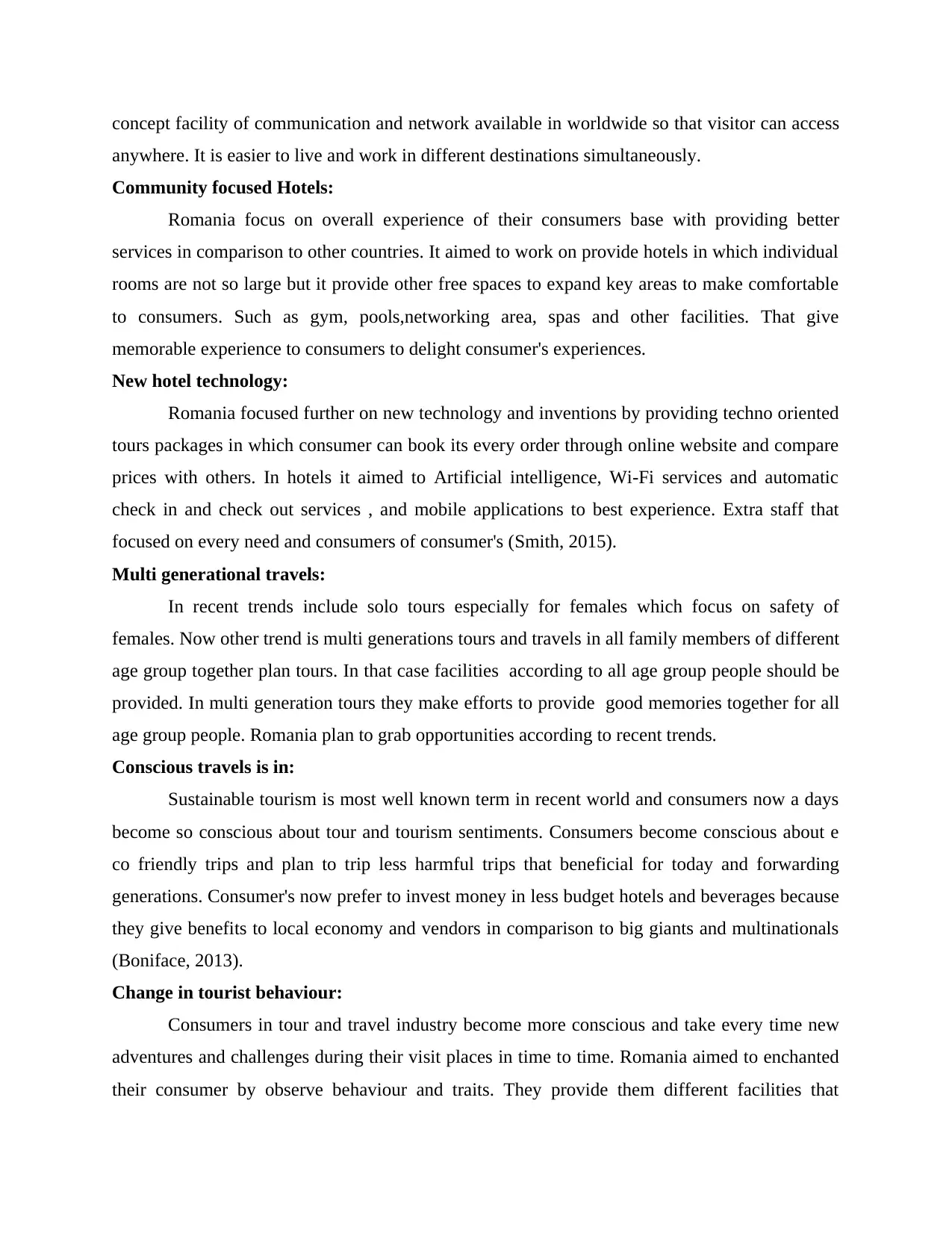
concept facility of communication and network available in worldwide so that visitor can access
anywhere. It is easier to live and work in different destinations simultaneously.
Community focused Hotels:
Romania focus on overall experience of their consumers base with providing better
services in comparison to other countries. It aimed to work on provide hotels in which individual
rooms are not so large but it provide other free spaces to expand key areas to make comfortable
to consumers. Such as gym, pools,networking area, spas and other facilities. That give
memorable experience to consumers to delight consumer's experiences.
New hotel technology:
Romania focused further on new technology and inventions by providing techno oriented
tours packages in which consumer can book its every order through online website and compare
prices with others. In hotels it aimed to Artificial intelligence, Wi-Fi services and automatic
check in and check out services , and mobile applications to best experience. Extra staff that
focused on every need and consumers of consumer's (Smith, 2015).
Multi generational travels:
In recent trends include solo tours especially for females which focus on safety of
females. Now other trend is multi generations tours and travels in all family members of different
age group together plan tours. In that case facilities according to all age group people should be
provided. In multi generation tours they make efforts to provide good memories together for all
age group people. Romania plan to grab opportunities according to recent trends.
Conscious travels is in:
Sustainable tourism is most well known term in recent world and consumers now a days
become so conscious about tour and tourism sentiments. Consumers become conscious about e
co friendly trips and plan to trip less harmful trips that beneficial for today and forwarding
generations. Consumer's now prefer to invest money in less budget hotels and beverages because
they give benefits to local economy and vendors in comparison to big giants and multinationals
(Boniface, 2013).
Change in tourist behaviour:
Consumers in tour and travel industry become more conscious and take every time new
adventures and challenges during their visit places in time to time. Romania aimed to enchanted
their consumer by observe behaviour and traits. They provide them different facilities that
anywhere. It is easier to live and work in different destinations simultaneously.
Community focused Hotels:
Romania focus on overall experience of their consumers base with providing better
services in comparison to other countries. It aimed to work on provide hotels in which individual
rooms are not so large but it provide other free spaces to expand key areas to make comfortable
to consumers. Such as gym, pools,networking area, spas and other facilities. That give
memorable experience to consumers to delight consumer's experiences.
New hotel technology:
Romania focused further on new technology and inventions by providing techno oriented
tours packages in which consumer can book its every order through online website and compare
prices with others. In hotels it aimed to Artificial intelligence, Wi-Fi services and automatic
check in and check out services , and mobile applications to best experience. Extra staff that
focused on every need and consumers of consumer's (Smith, 2015).
Multi generational travels:
In recent trends include solo tours especially for females which focus on safety of
females. Now other trend is multi generations tours and travels in all family members of different
age group together plan tours. In that case facilities according to all age group people should be
provided. In multi generation tours they make efforts to provide good memories together for all
age group people. Romania plan to grab opportunities according to recent trends.
Conscious travels is in:
Sustainable tourism is most well known term in recent world and consumers now a days
become so conscious about tour and tourism sentiments. Consumers become conscious about e
co friendly trips and plan to trip less harmful trips that beneficial for today and forwarding
generations. Consumer's now prefer to invest money in less budget hotels and beverages because
they give benefits to local economy and vendors in comparison to big giants and multinationals
(Boniface, 2013).
Change in tourist behaviour:
Consumers in tour and travel industry become more conscious and take every time new
adventures and challenges during their visit places in time to time. Romania aimed to enchanted
their consumer by observe behaviour and traits. They provide them different facilities that
Paraphrase This Document
Need a fresh take? Get an instant paraphrase of this document with our AI Paraphraser
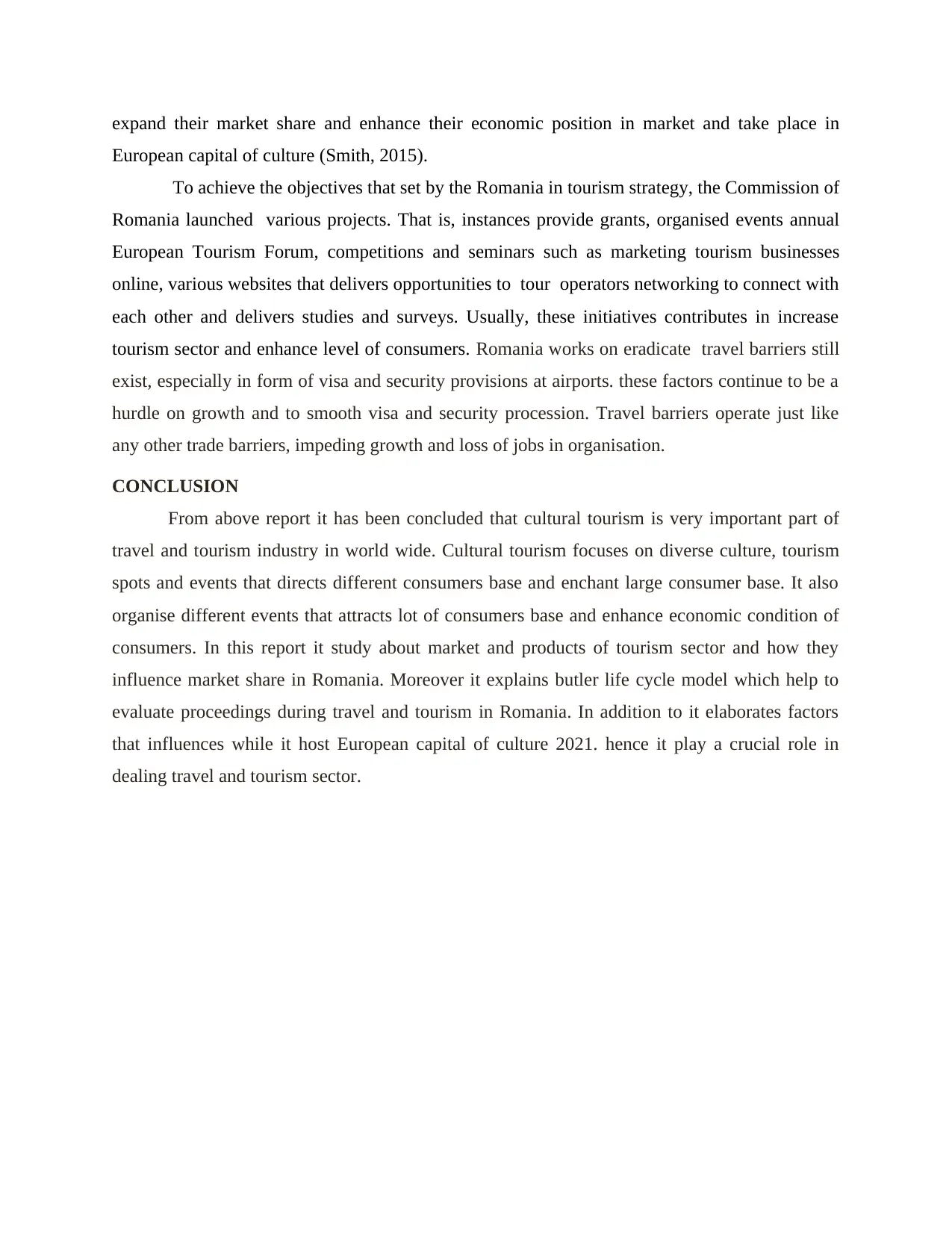
expand their market share and enhance their economic position in market and take place in
European capital of culture (Smith, 2015).
To achieve the objectives that set by the Romania in tourism strategy, the Commission of
Romania launched various projects. That is, instances provide grants, organised events annual
European Tourism Forum, competitions and seminars such as marketing tourism businesses
online, various websites that delivers opportunities to tour operators networking to connect with
each other and delivers studies and surveys. Usually, these initiatives contributes in increase
tourism sector and enhance level of consumers. Romania works on eradicate travel barriers still
exist, especially in form of visa and security provisions at airports. these factors continue to be a
hurdle on growth and to smooth visa and security procession. Travel barriers operate just like
any other trade barriers, impeding growth and loss of jobs in organisation.
CONCLUSION
From above report it has been concluded that cultural tourism is very important part of
travel and tourism industry in world wide. Cultural tourism focuses on diverse culture, tourism
spots and events that directs different consumers base and enchant large consumer base. It also
organise different events that attracts lot of consumers base and enhance economic condition of
consumers. In this report it study about market and products of tourism sector and how they
influence market share in Romania. Moreover it explains butler life cycle model which help to
evaluate proceedings during travel and tourism in Romania. In addition to it elaborates factors
that influences while it host European capital of culture 2021. hence it play a crucial role in
dealing travel and tourism sector.
European capital of culture (Smith, 2015).
To achieve the objectives that set by the Romania in tourism strategy, the Commission of
Romania launched various projects. That is, instances provide grants, organised events annual
European Tourism Forum, competitions and seminars such as marketing tourism businesses
online, various websites that delivers opportunities to tour operators networking to connect with
each other and delivers studies and surveys. Usually, these initiatives contributes in increase
tourism sector and enhance level of consumers. Romania works on eradicate travel barriers still
exist, especially in form of visa and security provisions at airports. these factors continue to be a
hurdle on growth and to smooth visa and security procession. Travel barriers operate just like
any other trade barriers, impeding growth and loss of jobs in organisation.
CONCLUSION
From above report it has been concluded that cultural tourism is very important part of
travel and tourism industry in world wide. Cultural tourism focuses on diverse culture, tourism
spots and events that directs different consumers base and enchant large consumer base. It also
organise different events that attracts lot of consumers base and enhance economic condition of
consumers. In this report it study about market and products of tourism sector and how they
influence market share in Romania. Moreover it explains butler life cycle model which help to
evaluate proceedings during travel and tourism in Romania. In addition to it elaborates factors
that influences while it host European capital of culture 2021. hence it play a crucial role in
dealing travel and tourism sector.
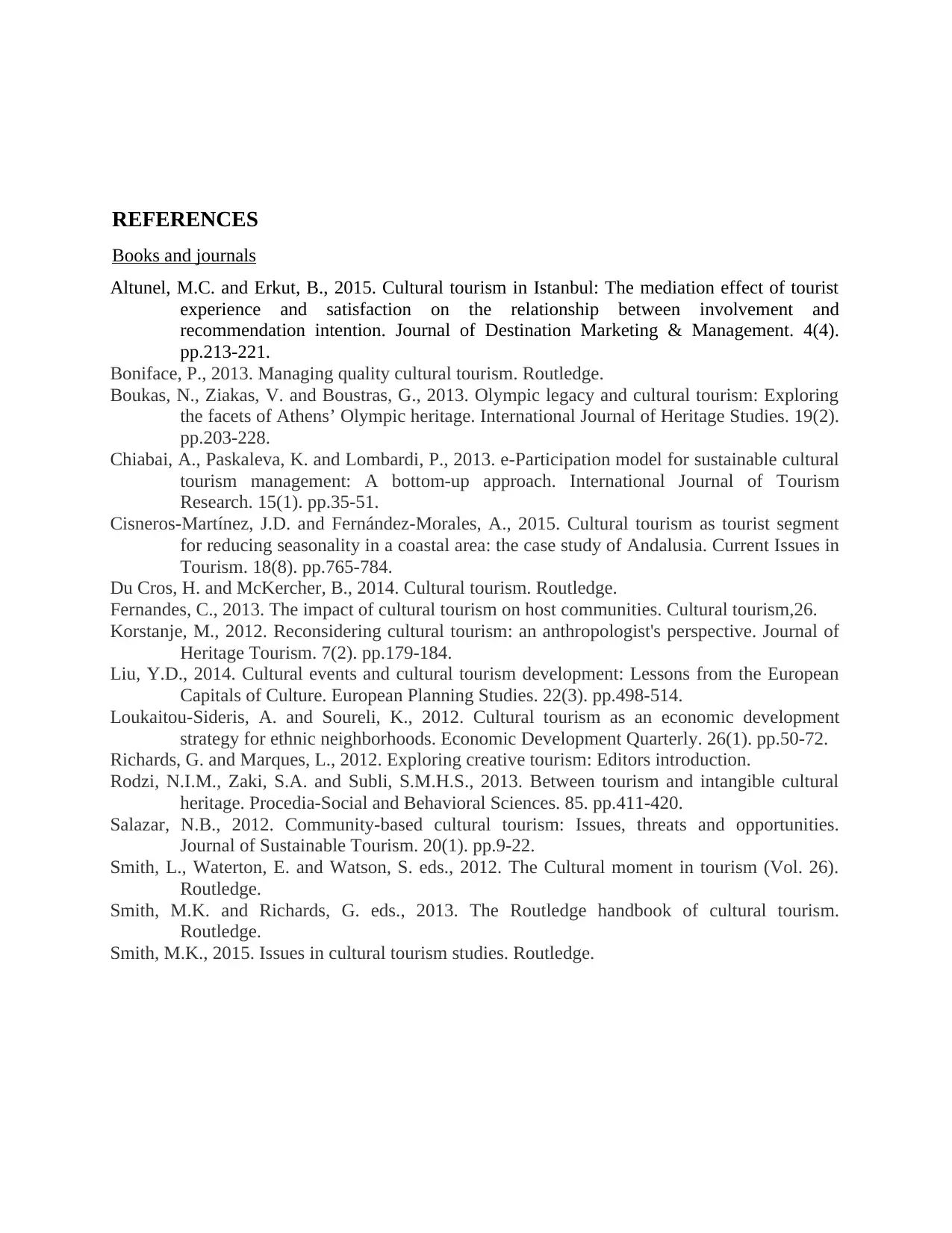
REFERENCES
Books and journals
Altunel, M.C. and Erkut, B., 2015. Cultural tourism in Istanbul: The mediation effect of tourist
experience and satisfaction on the relationship between involvement and
recommendation intention. Journal of Destination Marketing & Management. 4(4).
pp.213-221.
Boniface, P., 2013. Managing quality cultural tourism. Routledge.
Boukas, N., Ziakas, V. and Boustras, G., 2013. Olympic legacy and cultural tourism: Exploring
the facets of Athens’ Olympic heritage. International Journal of Heritage Studies. 19(2).
pp.203-228.
Chiabai, A., Paskaleva, K. and Lombardi, P., 2013. e‐Participation model for sustainable cultural
tourism management: A bottom‐up approach. International Journal of Tourism
Research. 15(1). pp.35-51.
Cisneros-Martínez, J.D. and Fernández-Morales, A., 2015. Cultural tourism as tourist segment
for reducing seasonality in a coastal area: the case study of Andalusia. Current Issues in
Tourism. 18(8). pp.765-784.
Du Cros, H. and McKercher, B., 2014. Cultural tourism. Routledge.
Fernandes, C., 2013. The impact of cultural tourism on host communities. Cultural tourism,26.
Korstanje, M., 2012. Reconsidering cultural tourism: an anthropologist's perspective. Journal of
Heritage Tourism. 7(2). pp.179-184.
Liu, Y.D., 2014. Cultural events and cultural tourism development: Lessons from the European
Capitals of Culture. European Planning Studies. 22(3). pp.498-514.
Loukaitou-Sideris, A. and Soureli, K., 2012. Cultural tourism as an economic development
strategy for ethnic neighborhoods. Economic Development Quarterly. 26(1). pp.50-72.
Richards, G. and Marques, L., 2012. Exploring creative tourism: Editors introduction.
Rodzi, N.I.M., Zaki, S.A. and Subli, S.M.H.S., 2013. Between tourism and intangible cultural
heritage. Procedia-Social and Behavioral Sciences. 85. pp.411-420.
Salazar, N.B., 2012. Community-based cultural tourism: Issues, threats and opportunities.
Journal of Sustainable Tourism. 20(1). pp.9-22.
Smith, L., Waterton, E. and Watson, S. eds., 2012. The Cultural moment in tourism (Vol. 26).
Routledge.
Smith, M.K. and Richards, G. eds., 2013. The Routledge handbook of cultural tourism.
Routledge.
Smith, M.K., 2015. Issues in cultural tourism studies. Routledge.
Books and journals
Altunel, M.C. and Erkut, B., 2015. Cultural tourism in Istanbul: The mediation effect of tourist
experience and satisfaction on the relationship between involvement and
recommendation intention. Journal of Destination Marketing & Management. 4(4).
pp.213-221.
Boniface, P., 2013. Managing quality cultural tourism. Routledge.
Boukas, N., Ziakas, V. and Boustras, G., 2013. Olympic legacy and cultural tourism: Exploring
the facets of Athens’ Olympic heritage. International Journal of Heritage Studies. 19(2).
pp.203-228.
Chiabai, A., Paskaleva, K. and Lombardi, P., 2013. e‐Participation model for sustainable cultural
tourism management: A bottom‐up approach. International Journal of Tourism
Research. 15(1). pp.35-51.
Cisneros-Martínez, J.D. and Fernández-Morales, A., 2015. Cultural tourism as tourist segment
for reducing seasonality in a coastal area: the case study of Andalusia. Current Issues in
Tourism. 18(8). pp.765-784.
Du Cros, H. and McKercher, B., 2014. Cultural tourism. Routledge.
Fernandes, C., 2013. The impact of cultural tourism on host communities. Cultural tourism,26.
Korstanje, M., 2012. Reconsidering cultural tourism: an anthropologist's perspective. Journal of
Heritage Tourism. 7(2). pp.179-184.
Liu, Y.D., 2014. Cultural events and cultural tourism development: Lessons from the European
Capitals of Culture. European Planning Studies. 22(3). pp.498-514.
Loukaitou-Sideris, A. and Soureli, K., 2012. Cultural tourism as an economic development
strategy for ethnic neighborhoods. Economic Development Quarterly. 26(1). pp.50-72.
Richards, G. and Marques, L., 2012. Exploring creative tourism: Editors introduction.
Rodzi, N.I.M., Zaki, S.A. and Subli, S.M.H.S., 2013. Between tourism and intangible cultural
heritage. Procedia-Social and Behavioral Sciences. 85. pp.411-420.
Salazar, N.B., 2012. Community-based cultural tourism: Issues, threats and opportunities.
Journal of Sustainable Tourism. 20(1). pp.9-22.
Smith, L., Waterton, E. and Watson, S. eds., 2012. The Cultural moment in tourism (Vol. 26).
Routledge.
Smith, M.K. and Richards, G. eds., 2013. The Routledge handbook of cultural tourism.
Routledge.
Smith, M.K., 2015. Issues in cultural tourism studies. Routledge.
⊘ This is a preview!⊘
Do you want full access?
Subscribe today to unlock all pages.

Trusted by 1+ million students worldwide
1 out of 12
Related Documents
Your All-in-One AI-Powered Toolkit for Academic Success.
+13062052269
info@desklib.com
Available 24*7 on WhatsApp / Email
![[object Object]](/_next/static/media/star-bottom.7253800d.svg)
Unlock your academic potential
Copyright © 2020–2025 A2Z Services. All Rights Reserved. Developed and managed by ZUCOL.




